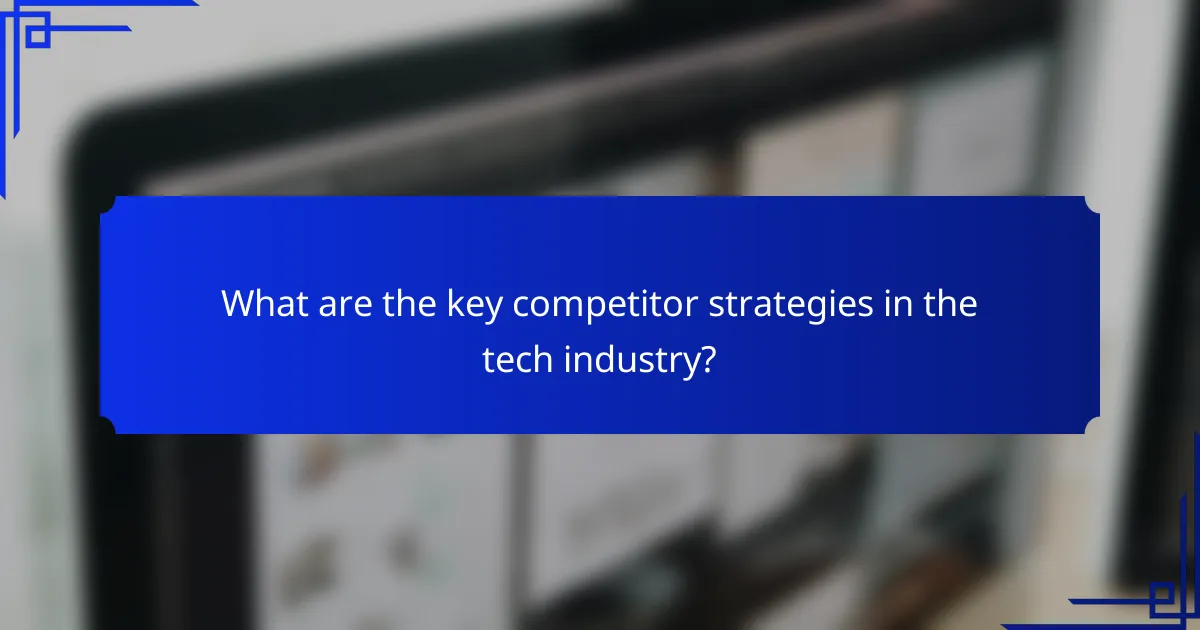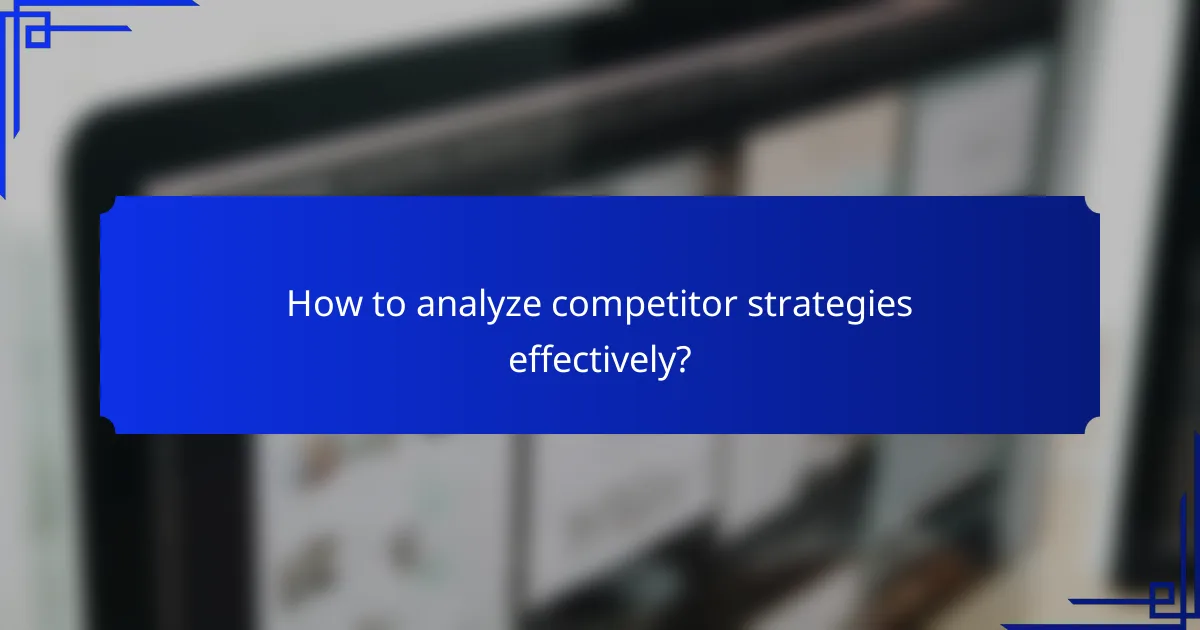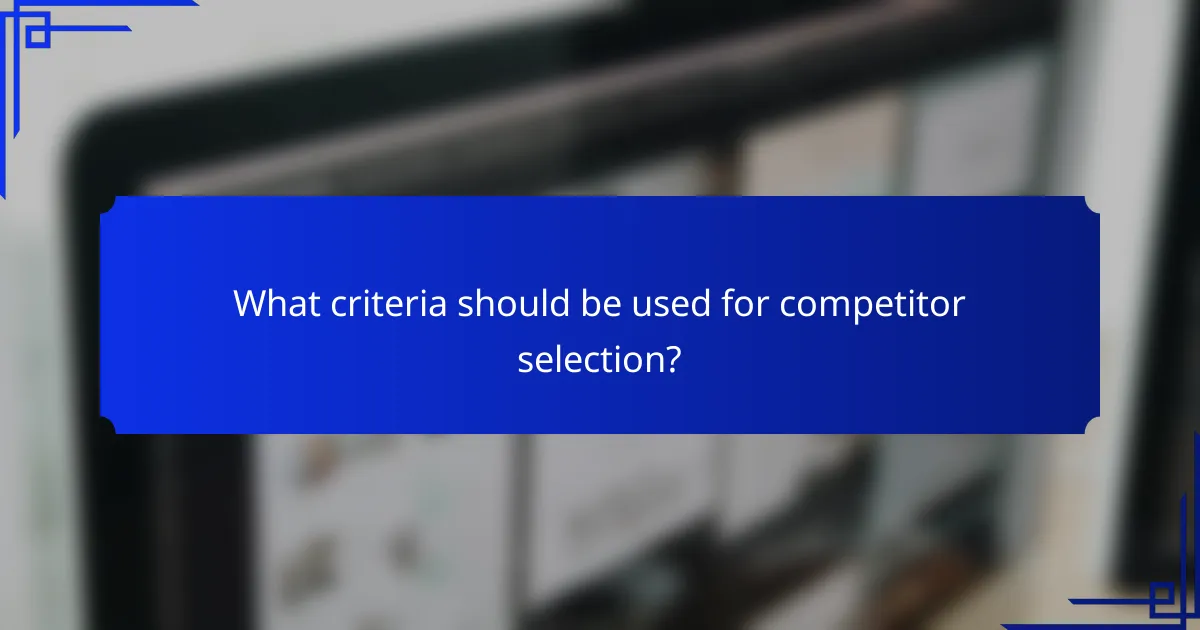In the rapidly evolving tech industry, understanding competitor strategies is crucial for maintaining a competitive edge. Key approaches include market share expansion, product enhancement, cost reduction, and innovation leverage. As of 2023, trends such as sustainability, digital transformation, and the integration of AI and machine learning are shaping these strategies, prompting companies to adapt to new market dynamics and consumer expectations.

What are the key competitor strategies in the tech industry?
Key competitor strategies in the tech industry focus on gaining market share, enhancing product offerings, reducing costs, and leveraging innovation. Companies often employ a combination of these strategies to maintain a competitive edge and respond to market dynamics.
Market penetration tactics
Market penetration tactics involve strategies aimed at increasing a company’s share within existing markets. This can include aggressive pricing, promotional campaigns, and enhancing distribution channels. For example, tech firms may offer discounts or bundled services to attract more customers and increase usage.
Common pitfalls include underestimating the importance of customer service and failing to adapt marketing messages to local cultures. Companies should ensure that their penetration strategies align with customer needs and preferences to be effective.
Product differentiation approaches
Product differentiation approaches focus on making a product stand out from competitors by emphasizing unique features or superior quality. This can involve innovative design, advanced technology, or exceptional customer support. For instance, a tech company might highlight its superior software capabilities or exclusive features to attract users.
To successfully differentiate, firms should conduct thorough market research to understand what features are valued by their target audience. Avoiding over-complication is crucial; clear messaging about what makes a product unique can drive customer interest.
Cost leadership methods
Cost leadership methods aim to become the lowest-cost producer in the industry, allowing companies to offer competitive prices. This can be achieved through economies of scale, efficient production processes, and cost-effective supply chain management. For example, a tech manufacturer might streamline operations to reduce overhead costs.
While pursuing cost leadership, companies must be cautious not to compromise on quality, as this can lead to customer dissatisfaction. Regularly reviewing cost structures and seeking innovative ways to cut expenses can help maintain this strategy effectively.
Innovation and technology adoption
Innovation and technology adoption are critical for staying relevant in the tech industry. Companies must continuously seek new technologies and innovative solutions to meet evolving customer demands. This could involve investing in research and development or adopting emerging technologies like artificial intelligence or cloud computing.
Successful innovation requires a culture that encourages experimentation and risk-taking. Companies should also be aware of the regulatory landscape, as compliance with standards can impact the pace of technology adoption. Engaging with customers for feedback during the development phase can enhance the relevance of new offerings.

How to analyze competitor strategies effectively?
To analyze competitor strategies effectively, focus on gathering data about their strengths, weaknesses, and market positioning. Utilize various frameworks and models to gain insights into their operations and identify areas for your own improvement.
SWOT analysis framework
The SWOT analysis framework helps you evaluate competitors by examining their Strengths, Weaknesses, Opportunities, and Threats. Start by listing key attributes of each competitor, such as their market share, product quality, and customer service.
For example, a competitor might have strong brand recognition (Strength), but poor customer reviews (Weakness). Identifying Opportunities, like emerging markets, and Threats, such as new regulations, can guide your strategic decisions.
Regularly updating your SWOT analysis ensures you stay informed about changes in the competitive landscape, allowing you to adapt your strategies accordingly.
Porter’s Five Forces model
Porter’s Five Forces model provides a framework for analyzing the competitive environment by assessing five key factors: competitive rivalry, threat of new entrants, bargaining power of suppliers, bargaining power of buyers, and threat of substitutes. Understanding these forces helps you gauge the intensity of competition in your industry.
For instance, if you find high competitive rivalry and strong buyer power, you may need to differentiate your offerings or improve customer relationships to maintain market share. Regularly reviewing these forces can reveal shifts in market dynamics that require strategic adjustments.
Benchmarking against industry leaders
Benchmarking against industry leaders involves comparing your business processes and performance metrics with those of top competitors. This practice helps identify best practices and performance gaps that can be addressed to enhance your competitive position.
Focus on key performance indicators (KPIs) such as sales growth, customer satisfaction, and operational efficiency. For example, if an industry leader achieves a customer satisfaction score of 90%, aim to understand their strategies and implement similar practices to improve your own score.
Establishing a regular benchmarking process allows you to track progress over time and stay competitive in your market segment.

What trends are shaping competitor strategies in 2023?
In 2023, competitor strategies are increasingly influenced by sustainability, digital transformation, and the adoption of artificial intelligence (AI) and machine learning. These trends reflect a shift towards more responsible business practices, enhanced technological integration, and data-driven decision-making.
Increased focus on sustainability
Companies are prioritizing sustainability as a core component of their strategies, driven by consumer demand and regulatory pressures. This includes adopting eco-friendly practices, reducing carbon footprints, and sourcing materials responsibly.
For instance, businesses are increasingly investing in renewable energy and sustainable supply chains. Brands that effectively communicate their sustainability efforts can enhance their reputation and attract environmentally conscious consumers.
Emphasis on digital transformation
Digital transformation is crucial for staying competitive, as businesses leverage technology to streamline operations and improve customer experiences. This trend involves integrating digital tools across all aspects of the organization, from marketing to supply chain management.
Companies should assess their current digital capabilities and identify areas for improvement. Implementing cloud solutions, enhancing online customer interactions, and utilizing data analytics are practical steps to facilitate this transformation.
Adoption of AI and machine learning
The adoption of AI and machine learning is revolutionizing how companies analyze data and make decisions. These technologies enable businesses to predict market trends, personalize customer experiences, and automate routine tasks.
Organizations should consider starting with pilot projects that apply AI to specific areas, such as customer service chatbots or predictive analytics for sales forecasting. This approach allows for manageable implementation and assessment of AI’s impact on efficiency and profitability.

How can businesses leverage competitor insights?
Businesses can leverage competitor insights by analyzing their strengths and weaknesses to identify opportunities for growth and improvement. This strategic approach allows companies to refine their own offerings and better meet customer needs.
Identifying market gaps
Identifying market gaps involves assessing competitors to find areas where customer needs are unmet. Businesses can conduct competitor analysis through market research, surveys, and social media monitoring to pinpoint these opportunities.
For example, if competitors lack a specific feature in their products, a business can develop that feature to attract customers. Regularly reviewing competitor offerings can help maintain awareness of shifting market demands.
Enhancing product offerings
Enhancing product offerings requires businesses to evaluate competitor products and identify areas for improvement. By understanding what competitors do well and where they fall short, companies can innovate their own products to better satisfy customer preferences.
For instance, if a competitor’s product is known for durability but lacks modern design, a business could focus on creating a stylish yet robust alternative. This approach not only differentiates the product but also appeals to a broader audience.
Improving customer engagement
Improving customer engagement can be achieved by analyzing how competitors interact with their customers. Businesses should observe competitors’ marketing strategies, customer service practices, and social media interactions to gather insights on effective engagement tactics.
For example, if a competitor excels in personalized marketing, a business might adopt similar tactics, such as targeted email campaigns or customized product recommendations. Engaging customers through multiple channels can enhance loyalty and drive sales.

What criteria should be used for competitor selection?
Competitor selection should be based on criteria that highlight their market position, influence, and geographic reach. These factors help in understanding their strategies and potential impact on your business.
Market share and influence
Market share indicates the percentage of an industry or market’s total sales that is earned by a particular company over a specified time period. Companies with larger market shares often have more influence over pricing and market trends, making them key competitors to analyze.
When assessing market share, consider both direct competitors and those in adjacent markets that could impact your business. For example, a company with a market share of 20% in the tech sector may influence pricing strategies and consumer preferences significantly.
Geographic presence
Geographic presence refers to the locations where competitors operate and sell their products or services. Understanding where competitors are active can reveal opportunities and threats based on regional market dynamics.
Evaluate whether competitors are local, national, or international. For instance, a competitor with a strong presence in Europe may have different strategies compared to one focused solely on the U.S. market. This geographic analysis can guide your own expansion or marketing strategies.
